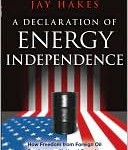I was recently visiting the La Brea Tar Pits in Los Angeles, a museum focused on one of the largest dinosaur finds in California. And I couldn’t help but think of where oil comes from.
Dinosaurs = oil.
No more dinosaurs = no more oil

Not exactly. As pointed out in the article “20 Things You Didn’t Know About Oil” (Discover magazine July 2008), “If you are a creationist, crude oil was formed by thousands of years of heat and pressure applied to the carcasses of plants and animals that died in the Great Flood. If you’re not, you think oil comes from dinosaurs, right?”
Okay, so regardless of where oil comes from we’re not getting more. So let’s get a grip and learn about how we can reduce our nonrenewable fossil fuel use.
 Enter A Declaration of Energy Independence written by Jay Hakes. Throughout the book, Hakes identifies seven solutions that can “help reduce dependence on foreign oil, strengthen the economy, and reduce emissions of greenhouse gases.”
Enter A Declaration of Energy Independence written by Jay Hakes. Throughout the book, Hakes identifies seven solutions that can “help reduce dependence on foreign oil, strengthen the economy, and reduce emissions of greenhouse gases.”
This was a good read. Hakes set his book apart from others by not giving a history lesson on the Middle East but giving us a much needed history lesson on America’s energy security efforts –the good the bad and the ugly.
It’s interesting to note that Hakes has been criticized for including global climate change in a book about energy security. However, Hakes points out rather convincingly (as does Thomas Friedman in Hot, Flat and Crowded) that energy independence and global climate change go hand-in-hand. It is irresponsible to develop an energy plan that remains dependent on fossil fuels especially when fossil fuels are the largest contributor to global climate change.
Here are Hakes’ Seven solutions:
1) Store Massive Emergency Reserves
2) Drive the Car of the Future
3) Bring Alternative Fuels to Market
4) Plug into an Electric Future
5) Adopt Energy Taxes Liberals and Conservatives Can Like
6) Make Energy Conservation a Patriotic Duty
7) Throw Some “Hail Marys”
Implementing these solutions may take a moderate amount of time, but the results will take a long time, says Hakes. We need to be in this for the long-term. Not stop our efforts because the price of gasoline has temporarily come down.
Now, if you want the full details of the seven solutions and how to achieve them, you’ll have to read the book. But let me conclude that Hakes has three keys to initiating the actions outlined above –paying more attention to Congress, increasing the political involvement of young people and finding elected officials who dare to lose.
Today, our 44th President is being sworn into office. He was elected by one of the most active group of voters in recent history. But the activation efforts can’t decrease now – they need to increase, and we need to deliver the message to President Obama, that he needs to focus on long-term solutions for energy security and global climate change not short-term fixes. Thanks, Hakes. I couldn’t have said it better myself.

